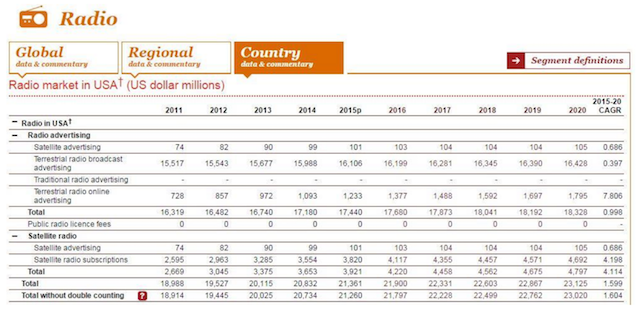 On Wednesday, we shared some of the pertinent data from the PwC Global Entertainment and Media Outlook. That assessment pointed to some general trends we can expect across 2016-2020 in music and Internet advertising. Today, we take a deeper dive into the numbers for the U.S. radio industry.
On Wednesday, we shared some of the pertinent data from the PwC Global Entertainment and Media Outlook. That assessment pointed to some general trends we can expect across 2016-2020 in music and Internet advertising. Today, we take a deeper dive into the numbers for the U.S. radio industry.
Advertising is a crucial component in radio revenue, and the projection shows very slow growth through 2020. The CAGR for all radio advertising is less than 1% for the period, with expectations to reach a total of $18.3 billion. That’s down from the CAGR of almost 1.1% set in PwC’s outlook last year. Terrestrial radio broadcast advertising is set to reach $16.4 billion by 2020, with a meagre CAGR of 0.4%. On the other hand, terrestrial radio online advertising is spiking up with a CAGR of 7.8%. That growth is projected to yield revenue just shy of $1.8 billion by the end of the period, but that total is more than double what it generated in 2011 ($728 million).
Satellite radio is slated to see more growth than the overall radio category, with anticipated total revenue of nearly $4.8 billion by 2020 on the back of a 4.1% CAGR. But satellite is also a more tempered five-year projection; last year’s report pegged the CAGR at almost 5.2%.
Those two main sections combine for a total estimated market value of $23 billion by 2020, with a CAGR of 1.6%. A comparison of the new PwC report with the figures laid out last year show the reining in of expectations for radio as a whole. Last year, the expected revenue was $22.51 billion for 2018 and $22.763 billion for 2019. This year, those figures have dipped to $22.499 billion and $22.762 billion, respectively.
The declines are small, but notable as radio continues to face challenges from online listening and new car audio technologies. Although Nielsen data has shown that radio has reach to 91% of the U.S. population age 12 and up, 44% of that same demographic are listening to online radio weekly.
Other research has pointed to fluctuations in the radio advertising market. For instance, in the monthly Standard Media Index, traditional radio advertising saw volume slump 16% on-year in January then bounce up 22% the following month, demonstrating how uncertain the market can be. The Radio Advertising Bureau’s 2015 results also pointed to digital and off-air sources as the sites of revenue growth, while spot revenue dwindled.
